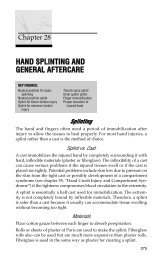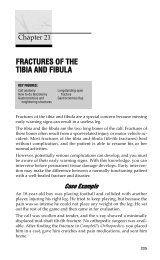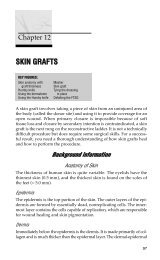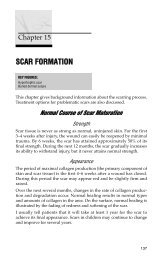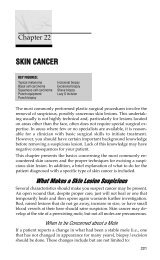finger fractures and dislocations - Practical Plastic Surgery
finger fractures and dislocations - Practical Plastic Surgery
finger fractures and dislocations - Practical Plastic Surgery
Create successful ePaper yourself
Turn your PDF publications into a flip-book with our unique Google optimized e-Paper software.
Chapter 30<br />
FINGER FRACTURES AND DISLOCATIONS<br />
KEY FIGURES:<br />
Rotational deformity<br />
Buddy taping<br />
Reduction of metacarpal fracture<br />
Because we use our h<strong>and</strong>s for so many things, <strong>finger</strong> <strong>fractures</strong> <strong>and</strong> <strong>dislocations</strong><br />
are common injuries. Unless they are associated with significant<br />
soft tissue injury, definitive treatment is not emergent. Often the initial<br />
evaluation <strong>and</strong> necessary splinting can be done by a nonspecialist.<br />
This chapter describes basic treatments for <strong>finger</strong> <strong>fractures</strong> <strong>and</strong> <strong>dislocations</strong><br />
that can be done by all health care providers. For the best possible<br />
outcome, however, more highly technical procedures may be required.<br />
Whenever possible, patients with all but the simplest injuries should<br />
be referred to a h<strong>and</strong> specialist for definitive treatment.<br />
An occupational therapist also should be consulted to help with rehabilitation<br />
once the fracture or dislocation has been properly treated.<br />
In areas where specialists are not available, the basic interventions discussed<br />
in this chapter can help the patient attain an acceptable functional<br />
outcome.<br />
DDeeffiinniittiioonnss<br />
To reduce a fracture or dislocation means to restore the proper anatomic<br />
<strong>and</strong> functional alignment of the bone or joint. For most h<strong>and</strong> injuries,<br />
functional status is most important to the patient.<br />
An open fracture or dislocation implies a wound in the soft tissues<br />
overlying the bone injury. In a closed injury the surrounding skin is<br />
intact. This distinction is important. An open fracture or dislocation<br />
has a high risk for infection. To prevent this complication, careful <strong>and</strong><br />
thorough wash-out of the wound is required. The patient also should<br />
be given antibiotics (the oral route is usually sufficient, but extent of<br />
injury is the determining factor) for at least 48 hours after the repair. A<br />
293
294 <strong>Practical</strong> <strong>Plastic</strong> <strong>Surgery</strong> for Nonsurgeons<br />
closed fracture or dislocation is not associated with a high risk of infection;<br />
thus, the patient does not require treatment with antibiotics.<br />
FFiinnggeerr FFrraaccttuurreess<br />
Compared with leg <strong>fractures</strong>, <strong>finger</strong> <strong>fractures</strong> may seem to be insignificant<br />
injuries. However, <strong>finger</strong> <strong>fractures</strong> can be quite problematic.<br />
Without proper treatment, a <strong>finger</strong> fracture can lead to significant limitation<br />
in h<strong>and</strong> function <strong>and</strong> disability.<br />
Anesthesia<br />
Administer a digital block before attempting to reduce a fracture. Use a<br />
combination of lidocaine <strong>and</strong> bupivacaine whenever possible to help<br />
with postprocedure pain control.<br />
Distal Phalangeal Fractures<br />
The distal phalanx is the most commonly fractured bone of the <strong>finger</strong>.<br />
Distal phalangeal <strong>fractures</strong> are classified into three types: tuft <strong>fractures</strong>,<br />
shaft <strong>fractures</strong>, <strong>and</strong> intraarticular <strong>fractures</strong>.<br />
Tuft Fractures<br />
A tuft fracture involves the most distal portion of the bone. It usually is<br />
caused by a crush mechanism, such as hitting the tip of the <strong>finger</strong> with<br />
a hammer. A tuft fracture is often an open fracture because of its<br />
common association with injury to the surrounding soft tissues <strong>and</strong>/or<br />
nail bed. Even without injury to surrounding soft tissue, the fracture is<br />
considered open in the presence of nail bed injury.<br />
Treatment<br />
1. The soft tissue wound should be cleansed thoroughly, <strong>and</strong> all foreign<br />
material should be removed.<br />
2. In patients with a subungual hematoma > 50% of the nail surface,<br />
consider removing the nail to allow repair of the nail bed (see chapter<br />
29, “Fingertip <strong>and</strong> Nail Bed Injuries”).<br />
3. Soft tissues should be sutured loosely in an interrupted fashion. Use<br />
4-0 nylon or chromic material. Repair the nail bed with 5-0 or 6-0<br />
chromic sutures. Repair of soft tissues usually leads to adequate reduction<br />
of the fracture.<br />
4. Cover the suture line with antibiotic ointment <strong>and</strong> dry gauze. The<br />
dressing should be changed daily.<br />
5. Keep the <strong>finger</strong> elevated as much as possible.
Finger Fractures <strong>and</strong> Dislocations 295<br />
6. Strongly advise the patient to avoid smoking. Tobacco products<br />
slow the healing process.<br />
7. Provide pain medication. Tuft <strong>fractures</strong> are often quite painful <strong>and</strong><br />
tender for several days.<br />
8. The patient may wear a protective splint or bulky dressing over the<br />
<strong>finger</strong>tip <strong>and</strong> distal interphalangeal (DIP) joint to prevent movement.<br />
The splint also protects the <strong>finger</strong> from accidental reinjury.<br />
However, do not immobilize the entire <strong>finger</strong> with the dressing or<br />
splint. Complete immoblization leads to unnecessary <strong>finger</strong> stiffness.<br />
9. Once the <strong>finger</strong> is less tender (usually within 10–14 days), encourage<br />
the patient to gradually resume normal use of the <strong>finger</strong>.<br />
Shaft Fractures<br />
Shaft <strong>fractures</strong> involve the central portion of the distal phalanx. They<br />
also are associated often with soft tissue or nail bed injuries. As described<br />
above, repair of any soft tissue usually leads to adequate reduction<br />
of the fracture.<br />
For further bone stabilization, a 20-gauge needle can be passed manually<br />
from the end of the <strong>finger</strong>tip into the bone segments. This procedure<br />
should be done before repair of any soft tissue injury (if present). The<br />
needle easily passes through the soft tissues into the bone if it is pushed<br />
firmly with a twisting motion. Bend the top part of the needle (the hub)<br />
so that it does not protrude too far from the end of the <strong>finger</strong>tip.<br />
Basically, shaft <strong>fractures</strong> are treated like tuft <strong>fractures</strong>. If a needle is used<br />
to stabilize the fracture, remove it when the <strong>finger</strong>tip is no longer tender.<br />
Intraarticular Fractures<br />
Intraarticular <strong>fractures</strong> involve the joint surface of the distal phalanx at<br />
the DIP joint. The patient may present with a mallet deformity (inability<br />
to extend the DIP joint fully) if the fracture involves the bony insertion<br />
of the extensor tendon. In this setting, treat the <strong>finger</strong> like a mallet<br />
<strong>finger</strong>, as described in chapter 32, “Tendon Injuries of the H<strong>and</strong>.”<br />
If there is no evidence of mallet deformity, the joint surface should be<br />
aligned as meticulously as possible to ensure optimal function. Such injuries<br />
are best referred to a h<strong>and</strong> specialist. If no specialist is available:<br />
1. Manipulate the <strong>finger</strong> to align the bone pieces as precisely as possible.<br />
2. Immobilize the DIP joint in 0–10° of flexion for 10–14 days. You can<br />
use a plaster splint or make a splint from a tongue depressor. Alternatively,<br />
the 20-gauge needle technique (described above) can be<br />
used to immobilize the DIP joint.
296 <strong>Practical</strong> <strong>Plastic</strong> <strong>Surgery</strong> for Nonsurgeons<br />
3. However you immobilize the joint, be sure to allow motion of the<br />
proximal interphalangeal (PIP) joint.<br />
4. When the <strong>finger</strong> is no longer tender, the patient should start moving<br />
the joint both passively <strong>and</strong> actively in hope of regaining functional<br />
range of motion at the DIP joint.<br />
Middle <strong>and</strong> Proximal Phalangeal Fractures<br />
Middle <strong>and</strong> proximal phalangeal <strong>fractures</strong> are classified according to<br />
whether they involve the joint surface.<br />
Extraarticular Fractures<br />
Extraarticular <strong>fractures</strong> affect the part of the bone that is not involved<br />
with the joint surface. The main concern is whether a rotational deformity<br />
is present when the patient attempts to bend the <strong>finger</strong>s. See chapter 26,<br />
“Normal H<strong>and</strong> Exam,” for discussion of rotational <strong>finger</strong> alignment.<br />
Any malrotation associated with metacarpal or phalangeal <strong>fractures</strong> must be<br />
corrected. Left, Normally all <strong>finger</strong>s point toward the region of the scaphoid<br />
when a fist is made. Right, Malrotation at the fracture site causes the affected<br />
<strong>finger</strong> to deviate. (From Crenshaw AH (ed): Campbell’s Operative<br />
Orthopaedics, 7th ed. St. Louis, Mosby, 1987, with permission.)<br />
If no rotational deformity is present, the <strong>finger</strong> can be treated by<br />
buddy taping for 2–3 weeks until the <strong>finger</strong> is no longer tender. Buddy<br />
taping is used to initiate gentle movement of the injured <strong>finger</strong> while<br />
maintaining proper bone alignment. The injured <strong>finger</strong> is taped to the<br />
adjacent <strong>finger</strong>, <strong>and</strong> the patient is instructed to use the h<strong>and</strong> as normally<br />
as possible.
Finger Fractures <strong>and</strong> Dislocations 297<br />
Table 1. Which Fingers to Use for Buddy Taping<br />
Injured Finger Finger Used for Buddy Taping<br />
Index Long<br />
Long Index<br />
Ring Long<br />
Little Ring<br />
Buddy taping. To promote protected<br />
motion of the injured <strong>finger</strong>, secure it to an<br />
adjacent noninjured <strong>finger</strong>.<br />
If a rotational deformity is present, give a digital block, <strong>and</strong> try to<br />
align the bone by manipulating the <strong>finger</strong>. Then place the <strong>finger</strong> in a<br />
volar splint.<br />
If the fracture involves the proximal phalanx, the splint should immobilize<br />
the PIP joint in 0° of flexion <strong>and</strong> the metacarpophalangeal (MCP)<br />
joints in 70° of flexion. If the fracture involves the middle phalanx, the<br />
splint should immobilize both the DIP <strong>and</strong> PIP joints in 0° of flexion.<br />
The splint should be worn for 2–3 weeks until the tenderness over the<br />
fracture site has resolved.<br />
After removing the splint, buddy-tape the <strong>finger</strong> for an additional 1–2<br />
weeks. This approach initiates gentle movement of the affected <strong>finger</strong><br />
<strong>and</strong> improves motion of the joints.<br />
Fractures with a rotational deformity should be treated by a h<strong>and</strong> specialist<br />
if one is available.
298 <strong>Practical</strong> <strong>Plastic</strong> <strong>Surgery</strong> for Nonsurgeons<br />
Intraarticular Fractures<br />
Intraarticular <strong>fractures</strong> involve the portion of bone that makes up the<br />
joint surface. Proper reduction is required to obtain adequate range of<br />
motion <strong>and</strong> <strong>finger</strong> function once the bone has healed. Intraarticular<br />
<strong>fractures</strong> usually require operative exploration for proper bony stabilization<br />
(with pins or screws) <strong>and</strong> thus should be treated by a h<strong>and</strong><br />
specialist if one is available. If no h<strong>and</strong> specialist is available, try the<br />
treatment described for extraarticular <strong>fractures</strong>.<br />
Metacarpal Fractures<br />
Metacarpal <strong>fractures</strong> are included in this chapter because they can<br />
affect the position <strong>and</strong> function of the affected <strong>finger</strong>. A poorly aligned<br />
metacarpal fracture can cause a rotational deformity.<br />
Metacarpal <strong>fractures</strong> may occur anywhere along the bone. Many require<br />
some type of pin fixation or stabilization for optimal treatment.<br />
Therefore, you should consult a h<strong>and</strong> specialist whenever possible.<br />
If no specialist is available, begin by checking <strong>finger</strong> rotation. If the <strong>finger</strong>s<br />
maintain proper alignment <strong>and</strong> the fracture looks reasonably well<br />
positioned on radiographs, a short period (2–4 weeks until the fracture<br />
site is no longer tender) of cast or splint immobilization may be all that<br />
is required.<br />
If a rotational deformity is present, reduction <strong>and</strong> manipulation must<br />
be performed before immobilization.<br />
Fracture Reduction<br />
Before the fracture is reduced a wrist block or a hematoma block<br />
should be given for pain control.<br />
Hematoma Block<br />
1. Draw up 3–5 ml of lidocaine in a syringe.<br />
2. Clean the area overlying the fracture with alcohol or povidoneiodine<br />
solution. This procedure must be done under sterile conditions<br />
so that you do not contaminate the area around the fracture<br />
site <strong>and</strong> cause an infection.<br />
3. Insert the needle into the tissues overlying the fracture until the tip<br />
of the needle contacts bone. Then back up the needle a few millimeters<br />
<strong>and</strong> inject 1–2 ml of solution.<br />
4. Without completely removing it from the skin, back up the needle<br />
<strong>and</strong> reposition the tip by a centimeter or so. Then inject the rest of<br />
the solution.
Finger Fractures <strong>and</strong> Dislocations 299<br />
Reduction Procedure<br />
1. Start by flexing the MCP joint.<br />
2. Apply downward pressure on the dorsal side of the fracture <strong>and</strong><br />
exert upward pressure at the MCP joint until you feel the bone fragments<br />
move into the proper position.<br />
3. Recheck <strong>finger</strong> alignment to ensure that the rotational deformity<br />
has been corrected. Repeat this procedure until proper alignment is<br />
achieved.<br />
Reduction of a metacarpal fracture. Arrows indicate the direction of pressure<br />
application for fracture reduction. (From Green DP, et al (eds): Operative H<strong>and</strong><br />
<strong>Surgery</strong>, 4th ed. New York, Churchill Livingstone, 1999, with permission.)<br />
4. Immobilize the h<strong>and</strong> with a cast or splint that includes the wrist<br />
(20–30° of extension) <strong>and</strong> MCP joints (60° of flexion). The interphalangeal<br />
joints can be left free so that you can monitor for rotational<br />
changes in the <strong>finger</strong>tips.<br />
5. If you place the h<strong>and</strong> in a cast, be sure to use several layers of<br />
padding to protect the skin, <strong>and</strong> do not wrap the plaster too tightly.<br />
6. The initial swelling from the injury should decrease after a few<br />
days. Therefore, the cast may need to be changed 5–7 days after<br />
injury to ensure adequate immobilization of the fracture site.<br />
7. The h<strong>and</strong> should be immobilized for 3–4 weeks. Watch for changes in<br />
the position of the <strong>finger</strong>tips, which may be a sign that the reduction<br />
has slipped. If so, repeat manipulation of the fracture is required.<br />
8. When the fracture site is no longer tender, the patient can begin to<br />
use the h<strong>and</strong> for light activity. Gradually increase activity over the<br />
next few months, as tolerated by the patient.
300 <strong>Practical</strong> <strong>Plastic</strong> <strong>Surgery</strong> for Nonsurgeons<br />
JJooiinntt DDiissllooccaattiioonnss<br />
For treatment purposes, <strong>finger</strong> joint <strong>dislocations</strong> can be classified as<br />
either simple or complex. A simple dislocation involves no fracture of<br />
the bone <strong>and</strong> can be reduced easily. A complex dislocation is not reducible<br />
or is associated with fracture of one of the involved bones. The<br />
main concern is whether the dislocation is reducible.<br />
Simple MCP Joint Dislocations<br />
Reduction of an MCP joint dislocation dem<strong>and</strong>s particular care. An incorrect<br />
reduction can change a simple dislocation into a complex one.<br />
Reduction Technique<br />
1. You may need to give a wrist block or gentle sedation for pain<br />
control.<br />
2. Flex the wrist to keep the flexor tendons slack.<br />
3. Avoid pulling on the <strong>finger</strong> <strong>and</strong> placing extension forces onto the<br />
joint.<br />
4. Apply direct digital pressure on the dorsal side of the base of the<br />
proximal phalanx, <strong>and</strong> push the proximal phalanx in a volar direction<br />
to reposition the proximal phalanx above the metacarpal head.<br />
After Reduction<br />
The joint will slide into a flexed position once the dislocation has been<br />
reduced. The patient is allowed to use the <strong>finger</strong>, but a splint should be<br />
placed on the dorsal surface of the h<strong>and</strong> (onto the <strong>finger</strong>) to prevent extension<br />
of the MCP joint beyond 0°. The patient should wear the splint<br />
until the joint is completely non-tender, usually for 2–3 weeks.<br />
Active <strong>and</strong> passive range-of-motion exercises should be done for several<br />
months to attain full motion in the joint.<br />
Simple Interphalangeal Joint Dislocations<br />
Often the patient presents after the dislocation is reduced. If reduction<br />
is required, use the following technique.<br />
Reduction Technique<br />
1. A digital block may be required for pain control.<br />
2. Apply gentle traction to the <strong>finger</strong> by grasping the <strong>finger</strong> distal to<br />
the affected joint. Gently pull on the <strong>finger</strong>, <strong>and</strong> the dislocation<br />
should reduce.
After Reduction<br />
Finger Fractures <strong>and</strong> Dislocations 301<br />
The affected joint(s) should be immobilized with a dorsal splint, keeping<br />
the joint in 20–30° of flexion for 5–7 days until the tenderness significantly<br />
decreases.<br />
The <strong>finger</strong> then should be buddy-taped for another 2–3 weeks. When<br />
the affected joint is completely pain-free, the taping can be stopped.<br />
Joint stiffness may remain for months. The patient should continue<br />
range-of-motion exercises until the <strong>finger</strong> moves normally.<br />
Complex Dislocations<br />
The treatment of a complex dislocation requires operative exploration,<br />
the description of which is beyond the scope of this text. Complex <strong>dislocations</strong><br />
require referral to a h<strong>and</strong> specialist.<br />
BBiibblliiooggrraapphhyy<br />
1. Glickel SZ, Barron OA, Eaton RG: Dislocations <strong>and</strong> ligament injuries in the digits. In<br />
Green DP, Hotchkiss RN, Pederson WC (eds): Green’s Operative H<strong>and</strong> <strong>Surgery</strong>, 4th<br />
ed. New York, Churchill Livingstone, 1999, pp 772–808.<br />
2. Kiefhaber TR, Stern PJ: Fracture <strong>dislocations</strong> of the proximal interphalangeal joint. J<br />
H<strong>and</strong> Surg 23A:368–380, 1998.<br />
3. Stern PJ: Fractures of the metacarpals <strong>and</strong> phalanges. In Green DP, Hotchkiss RN,<br />
Pederson WC (eds): Green’s Operative H<strong>and</strong> <strong>Surgery</strong>, 4th ed. New York, Churchill<br />
Livingstone, 1999, pp 711–771.




